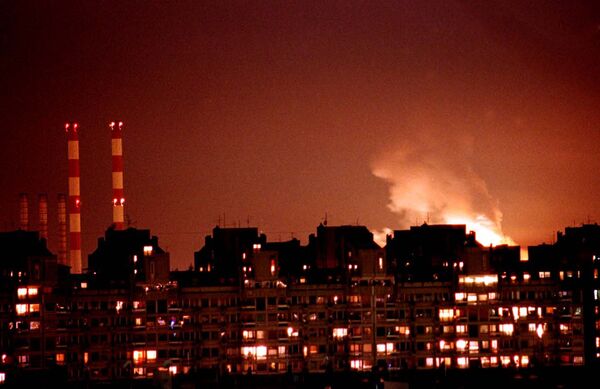- NATO’s campaign of air and missile strikes against the Federal Republic of Yugoslavia, which consisted of Serbia and Montenegro, lasted 78 days, ending on June 10, 1999.
- During the campaign, dubbed ‘Operation Noble Anvil’ by NATO, alliance warplanes carried out some 2,300 sorties against 995 facilities, firing nearly 420,000 missiles, bombs and other projectiles with a total mass of about 22,000 metric tonnes.
- The campaign included multiple violations of the laws of war, including the use of cluster bombs (37,000 of them), and depleted uranium projectiles, which led to major spike in oncological diseases, including juvenile cancer rates, after the war. According to Serbian doctors, the most widespread consequences of the use of such weapons have been thyroid disorders, cancers and foetus mutations. In 2017, Serbian scientist Ljubisa Rakic calculated that the amount of DU dropped on Yugoslavia was equivalent to about 170 Hiroshima bombs.

Bombing of Belgrade by NATO forces
© AP Photo / Dimitri Messinis
- According to Serbian estimates, the strikes on Yugoslavia left as many as 5,700 people dead, with 12,500 injured.
- NATO casualties included a US AH-64 Apache, an F-16C fighter, an AV-8B Harrier and an F-117A Nighthawk stealth bomber (the first and so far only case of a stealth fighter jet being destroyed in combat). On the Yugoslav side, military and police casualties included 631 troops and 325 policemen dead, with more than 50 missing. Due to the effective use of maskirovka or ‘military deception’ doctrine, The Yugoslav army was able to limit losses of military hardware (93 tanks lost out of an estimated 600), and other armoured vehicles, artillery and anti-aircraft systems.

Seen is an undated photo of a F-117 Nighthawk aircraft.
© AP Photo / U.S. Air Force, Msgt. Keith Reed
- The bombing is estimated to have caused as much as $100 billion in damage, destroying or damaging some 25,000 residential buildings, 470 km of roads, and 595 km of railway infrastructure. 14 airports, 19 hospitals, 20 health centers, 69 schools, 18 kindergartens, 176 cultural monuments and 38 bridges were destroyed. The bombing included a targeted raid on Radio Television of Serbia, which claimed 16 lives, and the accidental bombing of the Chinese Embassy, which killed 3 Chinese nationals. All told, Serbian officials estimate that over a third of NATO’s targets were civilian.
- NATO’s official justification for the strikes was its desire to protect Kosovar Albanians from ethnic cleansing and “a humanitarian catastrophe.” Before the war began, Albanian separatists allied to radical Islamist forces clashed with Serbian army and police forces in Kosovo, attacking authorities and attempting to drive ethnic Serbs out of the region. After the bombing campaign was completed and NATO troops entered the breakaway Serbian region in June of 1999, the separatists continued their campaign of violence against Serbs, in spite of NATO commitments to disarm the Kosovar militants.
- In 2008, the province unilaterally declared independence from Serbia. This forced over 200,000 ethnic Serbs to leave their homes. Belgrade, Russia, and many other countries have refused to recognize the breakaway republic. NATO troops, meanwhile, have remained in the province since 1999, establishing Camp Bondsteel, the second-largest US military base in Europe.
- In 2015, NATO Secretary-General Jens Stoltenberg expressed his “sincere regret” over the deaths and suffering of Serbian civilians. However, three years later at an event in Belgrade, the NATO chief emphasized that the bombing was not aimed against ordinary Serbs, but actually meant “to protect civilians and stop the Milosevic regime.” According to Stoltenberg, Serbs should “look to the future” and continue to shore up the “excellent relationship” between Belgrade and the bloc.





